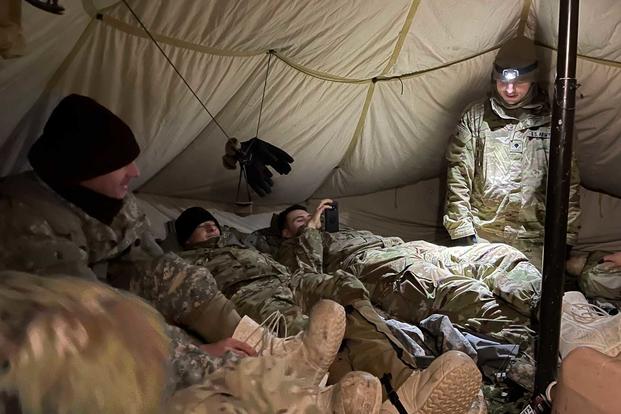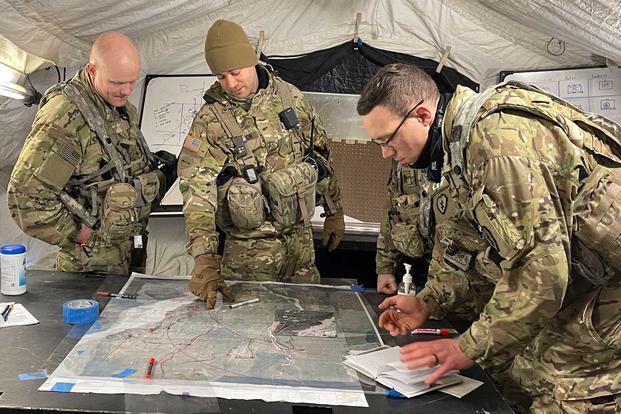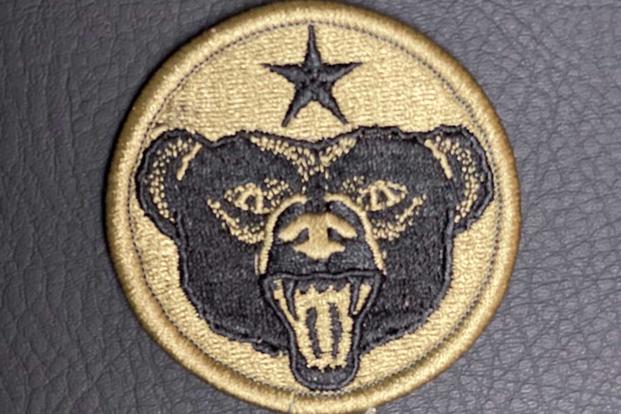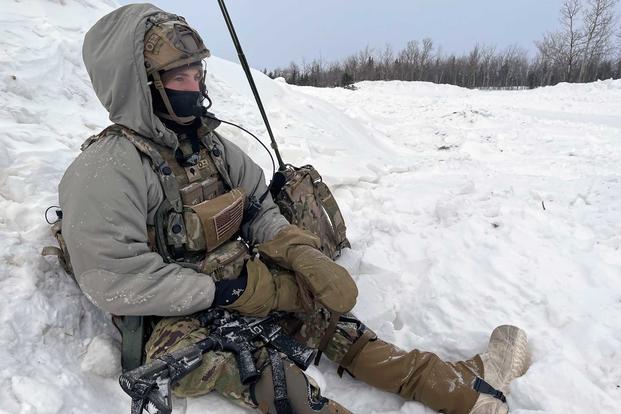FORT GREELY, Alaska -- Army paratroopers with the 4th Infantry Brigade Combat Team, 25th Infantry Division, set up fighting positions in the cold dark just before dawn near Fort Greely, Alaska, during a massive first-of-its-kind exercise in March.
Temperatures hit minus 20 degrees, but weren't the most frigid conditions the Arctic could dish out. "A warm day at the beach," joked a junior enlisted soldier, who had a dip in his mouth as he held an M249 light machine gun.
The soldiers had trudged through knee-high snow carrying rifles, Javelin anti-tank weapons and rucksacks to set up a mock convoy ambush for the exercise, but they would end up waiting days for the training scenario to begin. The Army's Stryker vehicles had broken down along the 100-mile route from Fort Wainwright to the site.

Many of the vehicles, visibly worn and pockmarked with chips and holes. were two decades old and saw service in Iraq. In March, they were barely running in Arctic conditions they weren't built to withstand, and being serviced by short-staffed mechanics without needed spare parts.
"The cold is hard on everything. All these Strykers were with me in Iraq in 2007; they were meant for the desert," a mechanic told Military.com. "It's so cold out here, the Stykers just freeze."
The exercise is part of a renewed Pentagon effort at Arctic warfare. The Army envisions the soldiers in Alaska as being the cold tip of the spear here. Top leaders such as Defense Secretary Lloyd Austin and Sergeant Major of the Army Michael Grinston have visited the force within the past year, and Army Secretary Christine Wormuth has been twice, including a trip on Wednesday.
But some leaders and troops in Alaska feel they are more of an afterthought, despite the high-profile attention. The faulty Strykers are emblematic of the problem they face. Military.com spent more than a week with U.S. soldiers based in the state; embedded with paratroopers; toured training areas; and interviewed key leaders, as well as dozens of rank-and-file troops.
Alaska soldiers were often equipped with the bare minimum for Arctic warfare and relied mostly on vehicles and gear used in more temperate environments, not the sub-zero austere conditions found in the world's coldest regions.
That gear included out-of-date tents; night-vision devices that froze from condensation; electronic gear that quickly died from the freezing temperatures; and sleds meant to carry important gear that fell apart. Soldiers were still wearing antiquated Army Combat Uniforms, or ACUs, years after the wear-out date. Some interviewed by Military.com had rips in their cold weather clothing needed for survival, and had been told they couldn't get new gear.
The 8,000 soldiers who participated in Alaska's first Combat Training Center, or CTC, exercise in March were testing out an envisioned cold-weather future as part of a new Arctic strategy unveiled last year. The training was created to dust off decades of doctrine on how to fight in harsh Arctic conditions as Pentagon planners shift to conventional warfare after years of fighting insurgents in the desert.
CTCs are weeks-long high-profile military exercises usually held at Fort Irwin, California, or Fort Polk, Louisiana, neither of which have terrains that make sense for Alaska-based units. It's unprecedented for a unit to effectively have a private, at-home CTC given the massive expense. That commitment is a sign Alaska-based units are likely becoming a priority for the Defense Department.
Tensions have escalated over the past decade as both China and Russia have made claims to the Arctic, which is rich with natural resources. Melting polar ice due to climate change is also opening up strategic shipping lanes for the first time.
Army leaders in Alaska have pointed to previous battles in Korea and Italy, as well as the Battle of the Bulge in Europe during World War II, as evidence of the need for tactics for surviving and thriving in Arctic combat.
The goal of the Alaska exercise was to test the existing cold-weather warfare skills and gear in minus 65-degree temperatures. But difficulties with the Strykers and other equipment cropped up, even though it rarely dipped below minus 20 degrees.
"We are not outfitted any differently than units in the lower 48," Sgt. Maj. Alex Kupratty, the command sergeant major for the 4th Infantry Brigade Combat Team (Airborne), 25th Infantry Division, told Military.com. "That's a problem in the extreme cold weather environment. We have the exact same gear. Every year, a lot of money is exhausted to winterize and get our equipment to survive the Arctic."
The exercise was proof that Pentagon planners haven't yet zeroed in on what the needs are for troops in Alaska. The weeks-long training events are built to mimic combat as much as possible after months of planning.
"We're not quite there yet. The question is if that's the best place for Strykers," Army Chief of Staff Gen. James McConville told Military.com. "That's the discussion right now."

What Troops Say They Need
Military leaders in Alaska interviewed by Military.com said they hoped new attention from the Pentagon could lead to better equipment and the increased support they need to be prepared for Arctic warfare. The use of Strykers was among the biggest concerns.
The 1-25th Stryker Brigade Combat Team's premier combat platform cannot be taken off road in the snow. The Stryker's operation manual says it isn't built to operate in conditions below minus 34 degrees Fahrenheit. Commanders in Alaska say they need gear and tactics that can work in minus 65 degrees, leaving key leaders unconvinced Stykers should have any role in the Arctic.
"It's not an Arctic platform, but they're here," Maj. Gen. Brian Eifler, commander of U.S. Army Alaska, told Military.com. "It's better than nothing. It's here for whatever reason years ago when they brought Strykers here. But it was never designed for extreme cold weather. So, the Army is going to try to figure out what is needed."
Alaska light infantry units rely on Small Unit Support Vehicles, or SUSVs, to get around. Those vehicles, bought in the 1980s, have tracks and are low to the ground. They can much more easily move in the snow and can carry a squad up a mountain. However, they have virtually no combat capabilities and no armor.

The Army wants to buy 13 Cold Weather All-Terrain Vehicles, or CATVs, for Alaska as part of its upcoming fiscal 2023 budget, Gabriel Camarillo, the service's undersecretary, told Military.com. CATVs have combat capabilities similar to other vehicles commonly used by infantry and cavalry units, but it is still unclear whether those vehicles will eventually replace the Stryker, which would require the purchase of dozens more.
The Army has proposed about $102 million for Alaska as part of its budget request for fiscal 2023 released in March, which includes $13 million for another CTC rotation that could bolster the Arctic soldiers' legitimacy. In addition to the vehicles and training, at least $40 million is being set for clothing and other personal gear. The funding must be approved by Congress.
"We want to regain the initiative in the Arctic we had previously had," Gen. Charles Flynn, commander of U.S. Army Pacific, said in a call with reporters. "The soldiers stationed here are uniquely positioned to learn how to operate and fight in these conditions."
As the Army's proposed budget works its way through Congress in the coming months, some see recent investments at Joint Base Elmendorf-Richardson, Fort Greely and Fort Wainwright as a step in the right direction. The service put $45 million toward winterized maintenance bays, and is spending $900,000 on gyms and quality-of-life improvements.
Yet something as simple as hiring more staff at dining facilities or mental health care providers can be a daunting task, with few incentives for people to relocate, something Eifler told Military.com is a key focus of efforts to win more funding from the Pentagon.
In Alaska, most rank-and-file soldiers and company-level commanders see themselves as a ragtag oddity in the force, often forgotten about by the lower 48 and the Pentagon more than 4,000 miles away. In total, roughly 20,000 U.S. troops are stationed in Alaska, about half of whom are in the Army.
"We're the redheaded stepchild of the Army," one senior noncommissioned officer said on the condition of anonymity. "I don't think they really know what to do with us."

Creating an Identity
Company-level commanders see the potential for soldiers there to be a semi-elite group -- a tier slightly above other conventional ground-combat units and perhaps other paratrooper units, such as the 173rd Airborne Brigade based in Italy and Germany.
Soldiers in Alaska are required to perform the same combat tasks but with more weight and under far more harsh, and often deadly, conditions. On top of that, they make up the closest combat-arms units to Russia and China in a contested region and possible front line in a future conflict.
But the lack of a clear identity for Alaska soldiers is seen as at least partly to blame for the lack of equipment support -- as well as a dearth of deployment opportunities. Their uniform patch illustrates the problem.
For most units, the mission and identity are clear. The 82nd Airborne Division, with its classic "All American" patch, gained famed for its legendary jump into Nazi-occupied France on D-Day and has since been the go-to conventional force for the Army.
But for Alaskan soldiers, it's muddy. The patch they wear is the 25th Infantry Division "Tropic Lightning," a reference to the division, which is mostly based in Hawaii. It is tasked with being the Army's premier unit for jungle warfare amid a new focus on the tropical environments in the Pacific -- the exact opposite of Alaska's mission.
"If you want an Arctic force, that requires a special type of soldier. Not everyone can do this. It is tough up here. That identity is key," Eifler said. "We need to find a better way to package the force up here. The 82nd, everyone knows what they do. Up here, not so much."
Many want to break away from the "Tropic Lightning" patch. Defense Department sources with direct knowledge of the situation said a new patch is being considered, but any timeline for a decision was unclear.
One option may be the U.S. Army Alaska bear patch, which right now is worn only by troops with U.S. Army Alaska, and attaching the "Arctic" tab to it by default. Currently, the tab is awarded to soldiers who complete the Army's two-week Cold Weather Leaders Course, which teaches Arctic survival.

However, to the ire of some soldiers, they cannot wear the Arctic tab outside of the Army's Pacific Command, which generally encompasses Alaska and Hawaii. A new unit patch could make the tab more akin to the "Airborne" or "Mountain" tab, which are not awards like the Ranger tab and are just part of the patch's design.
Another option would be keeping the Arctic tab, but as an award troops could wear anywhere after they earn it, like the Ranger tab. Right now, a soldier who earns that tab and is later stationed elsewhere, for example Fort Campbell, Kentucky, is not authorized to wear it. It is one of the Army's only awards limited to the geographic space where the soldier serves.
"We are working this, but nothing happens quickly in the Army," Gen. Michael Garrett, commander of U.S. Army Forces Command, told Military.com.
Another proposal under consideration that could help create a unique identity is allowing soldiers to stop shaving during the winter. Right now, it's standard procedure for troops to shave at night instead of the morning, which would up the chance of frostbite. But it's still unclear how much traction that idea is getting within the service.

Making Alaska Attractive for Soldiers
Meanwhile, the feeling of being neglected among soldiers, particularly the 4th Brigade Combat Team (Airborne), 25th Infantry Division, is also rooted in not being assigned tasks for global missions as often as its airborne counterparts.
Troops who hope to juggle roles of being the quarterback on extremely cold battlefields while handling deployments abroad may be mostly disappointed in Alaska, although Alaskan troops are set to deploy to Norway for an airborne training exercise this spring.
Any major change allowing more deployments abroad appears unlikely for now. The Army says the focus for Alaska-based units will be staying put and refining their combat doctrine, after spending 20 years juggling deployments in the Middle East and Afghanistan.
"The intent for the Arctic is we're going to have Arctic units, not units that live in Alaska and go other places," McConville said.
However, the Army is still betting on attracting soldiers to Alaska, despite the unique hardships. Leaders there all had a keen interest in making units almost exclusively volunteer. That would be a major shift from conventional Army units where soldiers are often involuntarily assigned to fulfill the needs of the service.
Volunteers could include soldiers who decline to be reassigned. Soldiers are typically reassigned every three to five years in the Army, but Eifler said the ability for soldiers to decide to stay would be a huge benefit because it can take multiple winters to fully understand how to operate in the frigid environment. Some lawmakers have proposed an extra $300 per month for all soldiers stationed there, but that money would likely only offset the extra cost of living associated with rural Alaska.
Right now, new recruits can enlist and be guaranteed to be stationed in Alaska. Building the exclusive club of Army Arctic warriors may only be possible because Alaska isn't for everyone. The isolation, harsh environment and time zone differences compared to much of the mainland U.S. can make it difficult for troops, especially younger soldiers, to adapt.
"What makes us more unique and better is that nobody else can do what we do, period. They can't survive like we can," Col. Jody Shouse, commander of the 4th Infantry Brigade Combat Team (Airborne), 25th Infantry Division, told Military.com. "It's harder to serve here than in the 82nd or 173rd."
-- Steve Beynon can be reached at Steve.Beynon@military.com. Follow him on Twitter @StevenBeynon.
Related: Alaska Army Leaders Scramble for Help After Spike in Suicides














